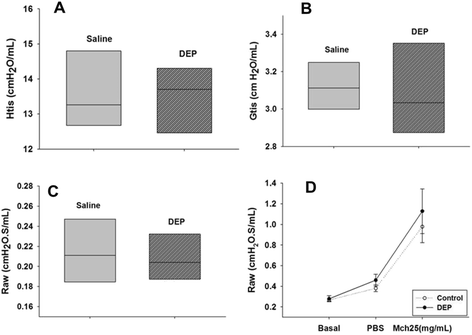Chronic exposure of diesel exhaust particles induces alveolar enlargement in mice
- PMID: 25848680
- PMCID: PMC4345004
- DOI: 10.1186/s12931-015-0172-z
Chronic exposure of diesel exhaust particles induces alveolar enlargement in mice
Abstract
Background: Diesel exhaust particles (DEPs) are deposited into the respiratory tract and are thought to be a risk factor for the development of diseases of the respiratory system. In healthy individuals, the timing and mechanisms of respiratory tract injuries caused by chronic exposure to air pollution remain to be clarified.
Methods: We evaluated the effects of chronic exposure to DEP at doses below those found in a typical bus corridor in Sao Paulo (150 μg/m3). Male BALB/c mice were divided into mice receiving a nasal instillation: saline (saline; n = 30) and 30 μg/10 μL of DEP (DEP; n = 30). Nasal instillations were performed five days a week, over a period of 90 days. Bronchoalveolar lavage (BAL) was performed, and the concentrations of interleukin (IL)-4, IL-10, IL-13 and interferon-gamma (INF-γ) were determined by ELISA-immunoassay. Assessment of respiratory mechanics was performed. The gene expression of Muc5ac in lung was evaluated by RT-PCR. The presence of IL-13, MAC2+ macrophages, CD3+, CD4+, CD8+ T cells and CD20+ B cells in tissues was analysed by immunohistochemistry. Bronchial thickness and the collagen/elastic fibers density were evaluated by morphometry. We measured the mean linear intercept (Lm), a measure of alveolar distension, and the mean airspace diameter (D0) and statistical distribution (D2).
Results: DEP decreased IFN-γ levels in BAL (p = 0.03), but did not significantly alter IL-4, IL-10 and IL-13 levels. MAC2+ macrophage, CD4+ T cell and CD20+ B cell numbers were not altered; however, numbers of CD3+ T cells (p ≤ 0.001) and CD8+ T cells (p ≤ 0.001) increased in the parenchyma. Although IL-13 (p = 0.008) expression decreased in the bronchiolar epithelium, Muc5ac gene expression was not altered in the lung of DEP-exposed animals. Although respiratory mechanics, elastic and collagen density were not modified, the mean linear intercept (Lm) was increased in the DEP-exposed animals (p ≤ 0.001), and the index D2 was statistically different (p = 0.038) from the control animals.
Conclusion: Our data suggest that nasal instillation of low doses of DEP over a period of 90 days results in alveolar enlargement in the pulmonary parenchyma of healthy mice.
Figures




Similar articles
-
Subchronic effects of nasally instilled diesel exhaust particulates on the nasal and airway epithelia in mice.Inhal Toxicol. 2010 Jun;22(7):610-7. doi: 10.3109/08958371003621633. Inhal Toxicol. 2010. PMID: 20429853
-
Sustained effect of inhaled diesel exhaust particles on T-lymphocyte-mediated immune responses against Listeria monocytogenes.Toxicol Sci. 2005 Nov;88(1):73-81. doi: 10.1093/toxsci/kfi279. Epub 2005 Aug 17. Toxicol Sci. 2005. PMID: 16107554
-
Anti-inflammatory effects of aerobic exercise in mice exposed to air pollution.Med Sci Sports Exerc. 2012 Jul;44(7):1227-34. doi: 10.1249/MSS.0b013e31824b2877. Med Sci Sports Exerc. 2012. PMID: 22297803
-
Effect of diesel exhaust particulate (DEP) on immune responses: contributions of particulate versus organic soluble components.J Toxicol Environ Health A. 2004 Feb 13;67(3):221-31. doi: 10.1080/15287390490266891. J Toxicol Environ Health A. 2004. PMID: 14681077 Review.
-
Diesel exhaust particles and airway inflammation.Curr Opin Pulm Med. 2012 Mar;18(2):144-50. doi: 10.1097/MCP.0b013e32834f0e2a. Curr Opin Pulm Med. 2012. PMID: 22234273 Review.
Cited by
-
Health and the Megacity: Urban Congestion, Air Pollution, and Birth Outcomes in Brazil.Int J Environ Res Public Health. 2022 Jan 20;19(3):1151. doi: 10.3390/ijerph19031151. Int J Environ Res Public Health. 2022. PMID: 35162175 Free PMC article.
-
Lung versus gut exposure to air pollution particles differentially affect metabolic health in mice.Part Fibre Toxicol. 2023 Mar 9;20(1):7. doi: 10.1186/s12989-023-00518-w. Part Fibre Toxicol. 2023. PMID: 36895000 Free PMC article.
-
Crucial role of pro-inflammatory cytokines from respiratory tract upon PM2.5 exposure in causing the BMSCs differentiation in cells and animals.Oncotarget. 2017 Dec 11;9(2):1745-1759. doi: 10.18632/oncotarget.23158. eCollection 2018 Jan 5. Oncotarget. 2017. PMID: 29416728 Free PMC article.
-
Nanoparticle pollution and associated increasing potential risks on environment and human health: a case study of China.Environ Sci Pollut Res Int. 2015 Dec;22(23):19297-306. doi: 10.1007/s11356-015-5497-0. Epub 2015 Oct 21. Environ Sci Pollut Res Int. 2015. PMID: 26490887
-
Integrating 4-D light-sheet fluorescence microscopy and genetic zebrafish system to investigate ambient pollutants-mediated toxicity.Sci Total Environ. 2023 Dec 1;902:165947. doi: 10.1016/j.scitotenv.2023.165947. Epub 2023 Aug 3. Sci Total Environ. 2023. PMID: 37543337 Free PMC article. Review.
References
Publication types
MeSH terms
Substances
LinkOut - more resources
Full Text Sources
Other Literature Sources
Medical
Research Materials

